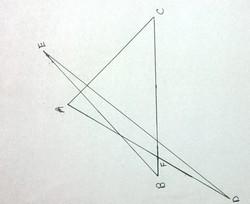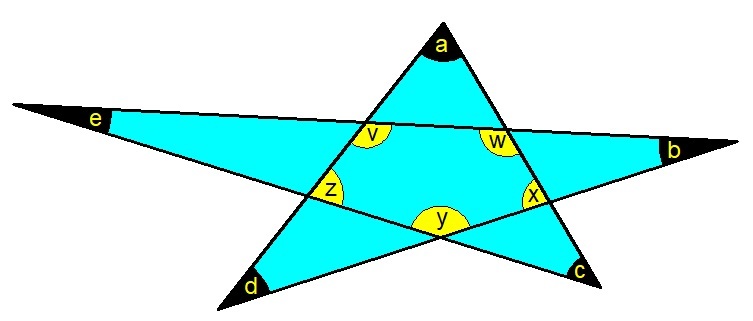A geometry problem by Sakanksha Deo
 ∠
A
+
∠
B
+
∠
C
+
∠
D
+
∠
E
=
?
∠
A
+
∠
B
+
∠
C
+
∠
D
+
∠
E
=
?
The answer is 180.
This section requires Javascript.
You are seeing this because something didn't load right. We suggest you, (a) try
refreshing the page, (b) enabling javascript if it is disabled on your browser and,
finally, (c)
loading the
non-javascript version of this page
. We're sorry about the hassle.
3 solutions
Apply exterior angle property in two triangles. Then use angle sum prop.
Method 1:

Let 1 , 2 , 3 , 4 and 5 be the angles of the irregular pentagram .
By the Exterior Angle Theorem , ∠ F G D = 1 + 3 because ∠ 1 and ∠ 3 are remote angles. It follows that ∠ G F D = 2 + 4 since it is an exterior angle with remote angles 2 and 4 . The sum of the interior angles of △ F G D = 1 + 3 + 2 + 4 + 5 = 1 8 0 ∘ . But these are the angles of the pentagram. Hence, the sum of the angles of the pentagram is 1 8 0 ∘ .
Method 2:
 Consider the diagram on the above.
Consider the diagram on the above.
v = 1 8 0 − ( b + d )
w = 1 8 0 − ( c + e )
x = 1 8 0 − ( a + d )
y = 1 8 0 − ( b + e )
z = 1 8 0 − ( a + c )
We know that v + w + x + y + z = 5 4 0 . So
1 8 0 − ( b + d ) + 1 8 0 − ( c + e ) + 1 8 0 − ( a + d ) + 1 8 0 − ( b + e ) + 1 8 0 − ( a + c ) = 5 4 0
9 0 0 − 2 ( a + b + c + d + e ) = 5 4 0
9 0 0 − 5 4 0 = 2 ( a + b + c + d + e )
3 6 0 = 2 ( a + b + c + d + e )
a + b + c + d + e = 1 8 0
Write a solution. ∠ A + ∠ C + ∠ A F C = 1 8 0 ... (1)
∠ B + ∠ D + ∠ E = ∠ B F D = ∠ A F C ... (2)
From (1) and (2) , we get ,
∠ A + ∠ B + ∠ C + ∠ D + ∠ E = 1 8 0